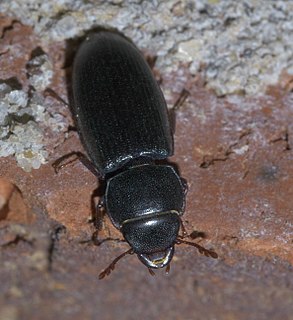
Melolontha is a genus of beetles in the family Scarabaeidae. The European cockchafers belong to this genus.

Geotrupes is a genus of earth-boring scarab beetles in the family Geotrupidae. There are at least 30 described species in Geotrupes.

The ruteline genus Chrysina, or jewel scarabs, is a large genus of brightly colored, often metallic iridescent species, ranging from the southwestern edge of the United States as far south as Venezuela and Ecuador. The genus includes all the species formerly known as Plusiotis. They are typically between 15–35 millimetres (0.59–1.38 in) in length, and are nocturnal in habits, coming readily to lights. The larvae live in rotting logs, while the adults commonly feed on foliage; they tend to be found in pine, juniper, or pine-oak forests, most commonly between 1,000–3,000 metres (3,300–9,800 ft) elevation. They are most diverse in countries such as Guatemala, where as many as 15 species can be found in a single location, but there are only 4 species which occur in the United States.

Buprestis is a genus of beetles in the family Buprestidae, the jewel beetles. As of 2011 there were 78 described species distributed across most of the world's biogeographic realms except parts of Africa and Antarctica.

Erotylidae, or the pleasing fungus beetles, is a family of beetles containing over 100 genera. In the present circumscription, it includes the subfamilies Dacninae, Encaustinae, Erotylinae, Megalodacninae, and Tritominae. In other words, the narrowly circumscribed Erotylidae correspond to the subfamily Erotylinae in the definition sensu lato. They feed on plant and fungal matter; some are important pollinators, while a few have gained notoriety as pests of some significance. Sometimes, useful and harmful species are found in one genus, e.g. Pharaxonotha. Most pleasing fungus beetles, however, are inoffensive animals of little significance to humans.

Carabus is a genus of beetles in family Carabidae. The genus is highly diverse with 91 subgenera and more than 1000 recognised species, thus is the largest genus in the subfamily Carabinae. The vast majority are native to the Palearctic, but 11 Nearctic species are also known. Carabus spp. are 12–50 mm (0.47–1.97 in) long, and most species are wingless and often very colourful. These are nocturnal, predatory beetles that feed on snails, earthworms, and caterpillars.

Polyphylla is a genus of scarab beetle includes more than 80 species distributed in North and Central America, southern and central Europe, northern Africa, and southern Asia—from Asia Minor to Japan. They typically reside in forests and orchards with most being identified by white elytra scales forming stripes. The adult beetles are often attracted to lights. Polyphylla lay their eggs on soil near plants from where the larvae hatch and burrow down to the roots on which they will feed. They reach maturity in two to three years.

Mordella is the type genus of the tumbling flower beetle family (Mordellidae), its subfamily Mordellinae and the tribe Mordellini. It is widely distributed in the Holarctic and adjacent regions. The larvae are primarily dead wood borers.

Pogonus is a genus of beetles in the family Carabidae, containing the following species:

Stictoleptura is a genus of longhorn beetle in the family Cerambycidae.

Trichodes is a genus of checkered beetles belonging to the family Cleridae, subfamily Clerinae.

Epicauta is a genus of beetles in the blister beetle family, Meloidae. The genus was first scientifically described in 1834 by Pierre François Marie Auguste Dejean. Epicauta is distributed nearly worldwide, with species native to all continents except Australia and Antarctica. Surveys have found the genus to be particularly diverse in northern Arizona in the United States. Few species occur in the Arctic, with none farther north than the southern Northwest Territory of Canada.

Ceroplesis is a genus of flat-faced longhorn beetle in the subfamily Lamiinae of the family Cerambycidae.

Zonitis is a genus of blister beetles in the family Meloidae. The genus was named and described by Johan Christian Fabricius in 1775.

Tenebroides is a genus of bark-gnawing beetles in the family Trogossitidae. There are at least 20 described species in Tenebroides.

Aclypea is a genus of carrion beetles in the family Silphidae. There are 11 described species in Aclypea.

Prostomis is a genus of beetle in the family Prostomidae.

















